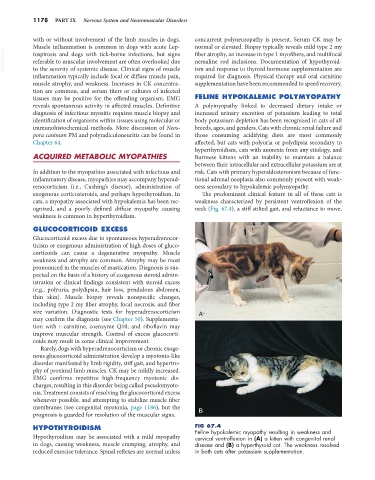Page 1206 - Small Animal Internal Medicine, 6th Edition
P. 1206
1178 PART IX Nervous System and Neuromuscular Disorders
with or without involvement of the limb muscles in dogs. concurrent polyneuropathy is present. Serum CK may be
Muscle inflammation is common in dogs with acute Lep- normal or elevated. Biopsy typically reveals mild type 2 my
VetBooks.ir tospirosis and dogs with tick-borne infections, but signs fiber atrophy, an increase in type 1 myofibers, and multifocal
nemaline rod inclusions. Documentation of hypothyroid-
referable to muscular involvement are often overlooked due
to the severity of systemic disease. Clinical signs of muscle
required for diagnosis. Physical therapy and oral carnitine
inflammation typically include focal or diffuse muscle pain, ism and response to thyroid hormone supplementation are
muscle atrophy, and weakness. Increases in CK concentra- supplementation have been recommended to speed recovery.
tion are common, and serum titers or cultures of infected
tissues may be positive for the offending organism. EMG FELINE HYPOKALEMIC POLYMYOPATHY
reveals spontaneous activity in affected muscles. Definitive A polymyopathy linked to decreased dietary intake or
diagnosis of infectious myositis requires muscle biopsy and increased urinary excretion of potassium leading to total
identification of organisms within tissues using molecular or body potassium depletion has been recognized in cats of all
immunohistochemical methods. More discussion of Neos- breeds, ages, and genders. Cats with chronic renal failure and
pora caninum PM and polyradiculoneuritis can be found in those consuming acidifying diets are most commonly
Chapter 64. affected, but cats with polyuria or polydipsia secondary to
hyperthyroidism, cats with anorexia from any etiology, and
ACQUIRED METABOLIC MYOPATHIES Burmese kittens with an inability to maintain a balance
between their intracellular and extracellular potassium are at
In addition to the myopathies associated with infectious and risk. Cats with primary hyperaldosteronism because of func-
inflammatory disease, myopathies may accompany hyperad- tional adrenal neoplasia also commonly present with weak-
renocorticism (i.e., Cushing’s disease), administration of ness secondary to hypokalemic polymyopathy.
exogenous corticosteroids, and perhaps hypothyroidism. In The predominant clinical feature in all of these cats is
cats, a myopathy associated with hypokalemia has been rec- weakness characterized by persistent ventroflexion of the
ognized, and a poorly defined diffuse myopathy causing neck (Fig. 67.4), a stiff stilted gait, and reluctance to move.
weakness is common in hyperthyroidism.
GLUCOCORTICOID EXCESS
Glucocorticoid excess due to spontaneous hyperadrenocor-
ticism or exogenous administration of high doses of gluco-
corticoids can cause a degenerative myopathy. Muscle
weakness and atrophy are common. Atrophy may be most
pronounced in the muscles of mastication. Diagnosis is sus-
pected on the basis of a history of exogenous steroid admin-
istration or clinical findings consistent with steroid excess
(e.g., polyuria, polydipsia, hair loss, pendulous abdomen,
thin skin). Muscle biopsy reveals nonspecific changes,
including type 2 my fiber atrophy, focal necrosis, and fiber
size variation. Diagnostic tests for hyperadrenocorticism A
may confirm the diagnosis (see Chapter 50). Supplementa-
tion with L-carnitine, coenzyme Q10, and riboflavin may
improve muscular strength. Control of excess glucocorti-
coids may result in some clinical improvement.
Rarely, dogs with hyperadrenocorticism or chronic exoge-
nous glucocorticoid administration develop a myotonia-like
disorder manifested by limb rigidity, stiff gait, and hypertro-
phy of proximal limb muscles. CK may be mildly increased.
EMG confirms repetitive high-frequency myotonic dis-
charges, resulting in this disorder being called pseudomyoto-
nia. Treatment consists of resolving the glucocorticoid excess
whenever possible, and attempting to stabilize muscle fiber
membranes (see congenital myotonia, page 1186), but the B
prognosis is guarded for resolution of the muscular signs.
HYPOTHYROIDISM FIG 67.4
Feline hypokalemic myopathy resulting in weakness and
Hypothyroidism may be associated with a mild myopathy cervical ventroflexion in (A) a kitten with congenital renal
in dogs, causing weakness, muscle cramping, atrophy, and disease and (B) a hyperthyroid cat. The weakness resolved
reduced exercise tolerance. Spinal reflexes are normal unless in both cats after potassium supplementation.

